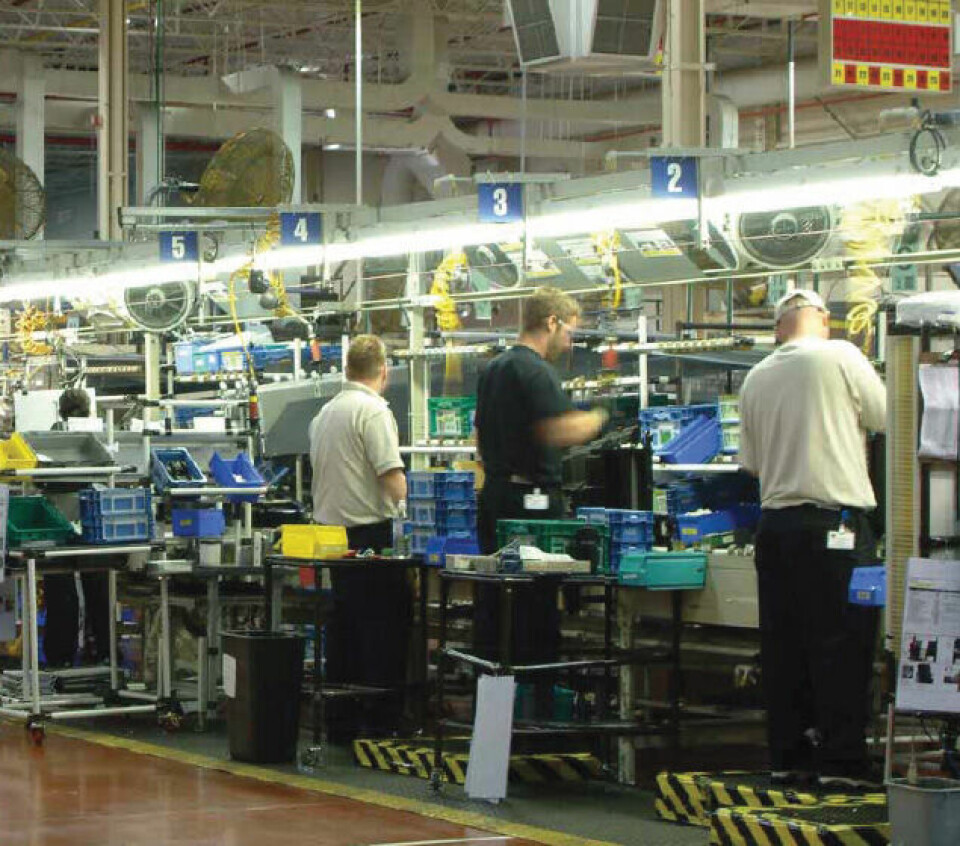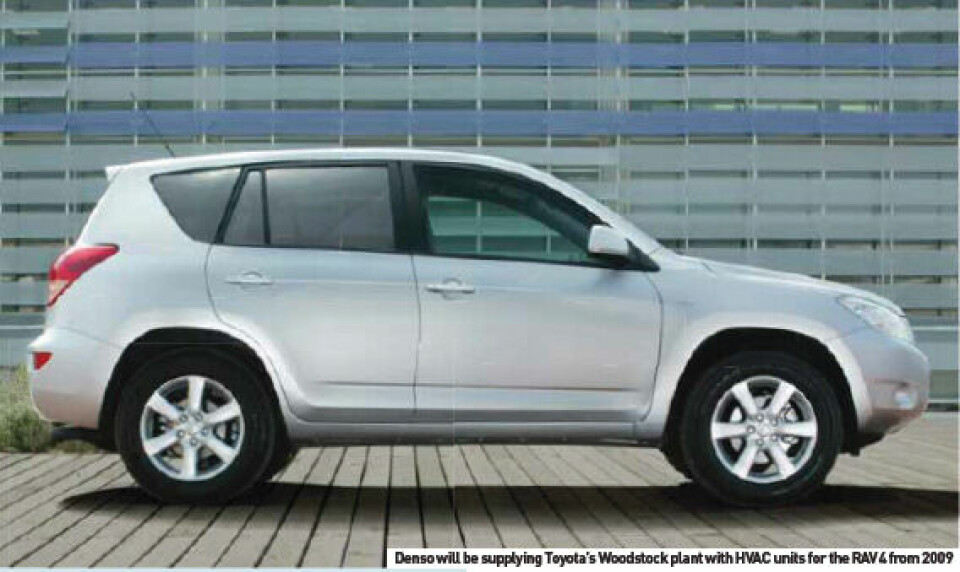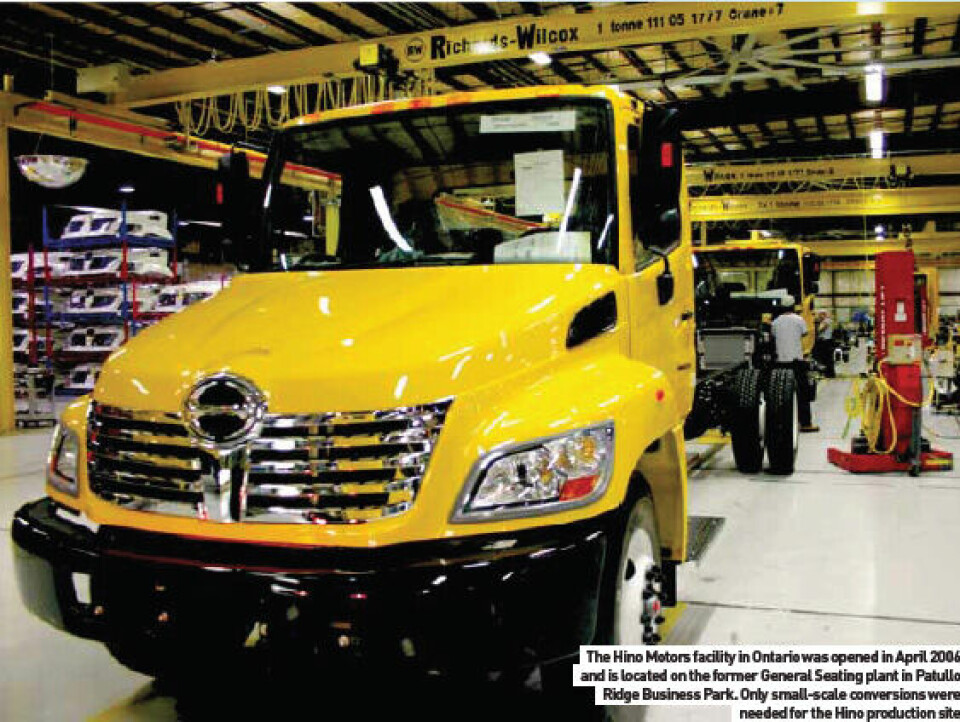Green is the new brown

Sometimes it just isn’t possible to build on a brownfield site, so those building on greenfield sites must do so in an environmentally sensitive way
As you might expect of a country as environmentally sensitive as Canada, the major OEMs and Tier Ones – most of which are concentrated in Ontario – face pressure to meet both national and provincial guidelines. While brownfield sites might be preferred by some of the smaller players for their expansion plans, companies such as Toyota, with its planned Woodstock, Ontario facility and Denso, in Guelph in the same province, have decided to build on greenfield sites. Toyota’s will be the first new plant in Ontario for the past 20 years.
By 2010, the Denso plant will be making radiators, condensers, engine fans and engine cooling modules, creating 300 new jobs in the process. President of Denso Manufacturing Canada (DMCN), Joe Stich, explains why the firm recently decided to expand a nine-year old HVAC facility to triple that of its former size (to 300,000 sq ft), ruling out a brownfield site.
Denso drew up its Eco Vision 2015 initiative three years ago. This project, which encompasses the group’s global manufacturing activities and employee actions, sets minimum standards over the mid- to long-term for all environmental activities. Beyond the group itself, this involves improving the environmental credentials of fi rms with whom Denso does business. Its credo is: “We shall aim to be in harmony with the environment and to live together within society, for the actualisation of a sustainable society.”
While some may scoff at Denso’s green ‘mantra’, and dismiss it as marketing talk, others see that the fi rm has been clever enough to use the guidelines to its own advantage. The company makes no attempt to disguise its links to Toyota Motor Corporation, for example, particularly its supply of components to the OEM’s Hybrid Synergy Drive powertrain systems. In the consumer world at least, Japan’s largest vehicle maker is now seen as the global leader when it comes to the business of saving the planet.
Companies working with Denso must comply with its strict Green Procurement Guidelines. This affects all parts and material suppliers. Further, procedures for chemical control systems are in place, designed to reduce the quantity of environmentally hazardous substances contained in parts and materials. The firm’s purchasing departments the world over must also be able to show that they actively seek out eco-friendly products.
A particular directive of Eco Vision 2015 that applies to the group’s HVAC plants, such as Guelph, is ‘the promotion and diffusion of new technology and products’, examples of which include the development of a natural refrigerant heat pump water heater. All the company’s HVAC component-producing divisions have an obligation to use natural air conditioning refrigerant that has a global warming factor of 150 or less. This applies to newmodel vehicles launched in the EU from 2011. The company is also investigating energy-saving air conditioning.
While certain countries in North America did not sign up to the Kyoto Protocol for the reduction of greenhouse gases, Denso has instructed all its plants in the region to work towards minimising their emissions, with Kyoto and global warming mentioned several times in Eco Vision 2015. With lighter vehicles suddenly in demand (witness Mazda’s 100 kilogramme weight-saving for the new Demio/Mazda2), and the exploding growth in intelligent telematics, Denso’s continued work to bring low-weight components to the market, along with its large investments in traffic-fl ow research show, like its parent, this Tier One is already looking beyond 2015.
AMS: Why has Denso chosen to expand, rather than go the brownfield route? How does this fit in with the environmental guidelines of the company’s Eco Vision 2015 project?

Joe Stich: This facility had extra land that we could build on. That was one of the advantages of setting up there, but we had to compete with other facilities in North America to be awarded the expansion. Denso analysed what the best opportunity was, and the costs of the choices we had. We felt this facility was best suited for the expansion we need to grow with our local customers. We are closely located to our customers, which is one big advantage we have. The workforce is highly skilled, so to go over to a new location – a brownfield site in another part of the province – made no sense to the company. Something else we look at closely is how we keep attracting the best people. We have an excellent education system in Ontario and and OEMs and Tier Ones work closely with educational facilities to ensure the right opportunities are in place to keep meeting the needs of companies like Denso. Another key factor in expanding in Guelph was the support we received from the regional government. We’ve had good cooperation in getting the permits to expand the business (which can present major difficulties in rival locations) and we work closely with the various ministerial departments who are keen to make sure we have the best business environment in which to operate successfully.
As the new 1,000-acre Toyota Motor Manufacturing Canada (TMMC) plant at Woodstock prepares for start-up, it’s worth remembering that this will be the fi rst greenfi eld location in Canada in the past two decades.
The new facility, some 100 kilometres south-west of Toronto, will build the RAV4, a mid-sized SUV that, along with others in its segment, is suddenly not quite as popular as it once was in its primary market, the US. Toyota formerly talked of 150,000 sales in its first year but this will almost certainly be scaled back because of the shrinking new vehicle market in Canada’s southern neighbour.
The company has invested CA$1.1 billion in its second Canadian plant (the fi rst, Cambridge, is also in Ontario), which will be have approximately 2,000 employees. This still only makes it half the size of the almost 20- year old CA$3.2 billion facility at Cambridge, another greenfield plant, making the Toyota Corolla and Matrix models, and the Lexus RX 350.
Not far from the new TMMC facility is a site that, while not quite brownfi eld in the pure sense of the term, is owned by another Toyota subsidiary, Hino Motors. With the opening of this facility in April 2006, Hino became the first Japanese truck maker to build vehicles in Canada.
The Hino Woodstock assembly complex is located at the site of the former General Seating plant in the Pattullo Ridge Business Park. The small-scale facility required only minor conversions and the lack of need for any major HAZMAT clean-up was one of the attractions. Spread over 11,000m2, there are just under 50 employees who assemble medium-duty trucks for the North American market.
Tellingly, the total area of the Hino Motors Canada site is 60,000m2. As the North American Class 6-7 shortnose conventional (Hino no longer offers cabovers) truck market at last shows the fi rst signs of recovery after an 18-month decline, Hino Motors Canada might be expected to make tentative inroads towards developing some of that extra land.
AMS: Did Denso look at cheaper sites that needed largescale funding to clean up?
JS: No, and the reason is that we made the decision in the 1990s that this was the right location for us, with room to expand. We also saw no need to take any risk in a brownfield site.
AMS: Wouldn’t the idea of cleaning up a HAZMAT site fit within Denso’s Eco Vision 2015 project?
JS: Traditionally – and this has been consistent – when Denso goes into an area looking to build, or expand, the company likes to know the facility, to know the land. There are specific ways in how buildings have to be put together, how locations need to be laid out, and once you start buying existing plants or brownfield sites, it’s difficult to follow through on some of these criteria. That is a decision that comes from Japan where there is a lot of experience in these issues on a global level. Under its Eco Vision 2015 project, Denso has specific goals; by working closely with our environmental rules, we can control and limit our impact at a site. For that reason, a greenfield site works best.
AMS: Has Denso learned from observing its rivals and the difficulties they may have encountered with brownfields?
JS: I have certainly seen some rivals get bound up with major difficulties – I’m talking about companies in the US – trying to overcome some of the major contamination obstacles at a location. This becomes a major distraction for the company, to have to spend so much time trying to solve these issues rather than spending that time focusing on making products and servicing its customers.

AMS: What are the main problems in these cases?
JS: Time is a big problem but there is usually a major financial commitment to be made. The total costs are not always obvious when you begin to look at a brownfield location, but these can quickly escalate, depending on the history of the site and what you are planning to build there. This is why Denso has a policy of avoiding these sorts of locations, where we can.
AMS:What are Denso’s environmental policies regarding its manufacturing plants?
JS: Denso has a strong belief in the Eco Vision 2015 project worldwide and we are looking at key activities that make sure our carbon footprint is as minimal as possible, no matter where we manufacture.
Eberspaecher, an exhaust and catalytic converter manufacturer headquartered in Esslingen am Neckar in Germany, is looking to invest US$50m in its Brighton, Michigan plant through a brownfield redevelopment plan. While the supplier wants to expand its Paramount Industrial Park site and bring new jobs to the area, it has also called on local authorities to approve a plan awarding tax credits to offset some of the cost.
Opened in 2003, the plant produces catalytic converters for both foreign and domestic car customers. The company last expanded its Brighton operation in 2006, building a 55,000 sq ft extension for new mufflers and bent tubes manufacturing. Its workforce is just under 200. If given fi nal approval by the state, the latest proposal would result in 70 new full-time jobs.
Meeting emissions standards
Eberspaecher is further considering converting the Brighton plant into a technology facility, focusing on cutting-edge products, enabling it to produce low-emission catalytic converters and related items to meet the next round of US emissions standards for heavy trucks.
The tax credit has been requested because of some site contamination, and has been applied for through the Michigan Economic Growth Authority board. To apply for the credits, Eberspaecher fi rst had to submit an approval plan at a local level. Should this meet with success, the Tier One manufacturer plans to move its existing car exhaust systems manufacturing plant from Brighton to another location in late 2008.
The process that companies such as Eberspaecher must go through, even in a region as familiar with the needs of OEMs and suppliers as Michigan, perfectly illustrates why so many choose greenfi eld locations for expansion. In the case of the Brighton plans, there must first be a public hearing on the issue. Then the city council needs to take a vote on the issue and then the Michigan Economic Development Corporation has a say.
From the city’s point of view, creating incentives for companies it regards as good corporate citizens makes sense, especially when expanding suppliers and OEMs want to work with a brownfield location. The city of Brighton is also taking a longer-term view, seeing that with relatively affordable incentives now, many more tax dollars will keep fl owing into the city’s economy for years to come.
We have a long-term vision, to get us to our goals by 2015, and Guelph plays a role in that, with targets to be achieved by 2010 and 2013. So our expansion has to work with those goals. We’re in the middle of our expansion. We’re adding about 200,000 square foot (18,580 square meter of manufacturing space and we are doubling the population here, growing from about 300 to 600 people.
AMS: Why does Denso not simply supply the Ontariobased customers from any or several of its US operations? Surely the cost of adding capacity at Guelph is prohibitive? JS: Denso used to ship HVAC components to our customers in Canada but a decision was made that saw us setting up this greenfield plant in 1999. While we have high costs on a superficial level, when you look at how expensive freight has become – which is just one factor - our local operations can certainly compete.
Our customers are also concerned with us being able to supply their plants in this area. With Toyota adding a plant in Woodstock, which is about 60 kilometres from our site, Denso felt it needed to provide better opportunities to support the Toyota expansion as well as that of other OEMs in Ontario.
AMS: What products will be supplied to Woodstock and when will this start?
JS: The plant will be producing the Toyota RAV4 and Denso will supply the HVAC system for that vehicle from 2009. Our expansion will also allow us to expand our product base into engine cooling modules. Denso will make radiators, condensers, and electric fans and motors, combining these in modules, which will be shipped to Woodstock. This is a technology that has been used for several years, and one that we produce globally.
AMS: Toyota’s Cambridge facility is the only one outside Japan that makes Lexus vehicles. Is Denso involved in new products for that plant where a replacement for the RX 350 crossover is scheduled for 2009?
JS: The next-generation Lexus RX will come off the line in January 2009. That’s when Denso will start producing the engine cooling module as well as continuing to supply the HVAC system from Guelph.
AMS: What percentage of your business is with Toyota and Honda?
JS: The combination is about 60 per cent of our total business. We feel that some of our greatest growth potential is with GM, Ford and Chrysler in Ontario.
AMS: In spite of the downsizing that is currently gripping the Detroit Three’s local plants in Ontario, GM only recently announced its intentions to shutter Oshawa Truck, for example, ending build of the Chevy Silverado and GMC Sierra pick-ups. Can Denso expand and, if so, how?
JS: Yes, even with that, we feel that we can expand our business.
From a quality perspective. These companies demand the highest-quality products and they know our reputation for that. By having our operations at a local level – this is where the expansion into the greenfield location at Guelph comes into it – we have a cost advantage over some of our foreignbased competitors.
AMS: In terms of your competition, you’re up against US-based Tier Ones. So how can you compete when they now have what is increasingly an emerging market level of wages in some parts of the US?
JS: You need to take into account the total cost package. We work closely with the province and they are very supportive of our operations.
Denso is also a company that traditionally takes a longterm view. It is a competitive business environment but again, it is our local location, the stability of our operations and the whole package of government-funded healthcare costs for workers in Canada – these all play a part in helping us keep business and also put us high on OEMs’ lists when they tender for new business.
AMS: Why doesn’t Denso simply import parts from its US plants – after all, Canada now has a far stronger currency than the US dollar and Michigan is so close?
JS: With Toyota adding their plant in Woodstock, which is about 60 kilometres from our location, we really felt we needed to provide better facilities to support that expansion. The Ontario area produces about 1.6 million vehicles a year, so it’s a major part of North America’s total manufacturing. To have a Tier One operation in Ontario is essential for supporting not just Toyota and Honda, our main customers, but others such as Ford, for its Edge crossover, and also Chrysler.


